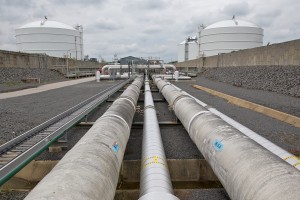FERC rejects environmentalists appeal on Cove Point LNG exports
-
Susan Phillips

Lindsay Lazarski / WHYY
A seagull takes flight from the offshore loading pier at Cove Point out into the Chesapeake Bay. Construction on the idled terminal in Lusby, MD is expected to be completed by the end of 2017.
The Federal Energy Regulatory Commission has denied a request by several environmental groups to halt construction on Dominion Energy’s Cove Point LNG export terminal in Lusby, MD and conduct a more thorough environmental review. Environmentalists have been fighting the conversion of the mothballed import terminal into an import/export facility, saying FERC should consider the environmental impact of upstream Marcellus Shale production.
FERC had approved the project in September, after conducting an environmental assessment, which is less stringent than an environmental impact statement. The project, which is expected to be completed by the end of 2017 will ship out more than 5 million metric tons of liquefied natural gas each year. Cove Point is the fourth export terminal approved by the Federal Energy Regulatory Commission, or FERC. The agency issued its opinion regarding environmental opposition this week.
Ryan Talbott, an attorney and executive director of the Allegheny Defense Project, says he wasn’t surprised by FERC’s decision.
“One of the problems with FERC’s environmental analysis, and every analysis they do whether it’s for compressor stations or pipelines, is it’s all being done to develop to Marcellus and Utica shales,” said Talbott. “Under federal law they have an obligation to consider the cumulative effects.”
Talbott says the export plant is connected to, and dependent upon, increased natural gas drilling in Pennsylvania’s Marcellus Shale. He argues that the National Environmental Policy Act (NEPA) requires FERC to include shale gas development in its environmental analysis of the project.
But in the decision, issued Monday, FERC says Marcellus Shale gas development will continue with or without the Cove Point export terminal. Additionally, FERC says Dominion’s facility would not necessarily process natural gas from the Marcellus and Utica Shales.
The order explained that future Marcellus Shale production is not an essential predicate for the Cove Point Liquefaction Project, which can receive natural gas through interconnects with three interstate natural gas pipeline systems. Further, development of the Marcellus Shale region will likely continue regardless of whether the Cove Point Liquefaction Project is approved.
But Talbott says exports will be a significant driver of shale gas development, which his organization opposes.
Marcellus Shale producers have experienced a significant drop in gas prices due, in part, to the lack of pipelines to transport the gas to high demand markets. Producers are eager to export because the gas will fetch a higher price overseas.
Karl Neddenien, a spokesman for Dominion’s Cove Point project, says FERC made the right decision.
“It reaffirms that the Cove Point project can be constructed and operated with minimal impact on the environment and bring significant economic benefits to the local community of Lusby, Maryland, to the state of Maryland and to the nation,” said Neddenien.
Neddenien says construction began in late October, and has continued since.

Lindsay Lazarski / WHYY
Liquefied natural gas pipes circulate around the Cove Point terminal into holding tanks.
The Allegheny Defense Project’s Ryan Talbott says he’s frustrated by the length of time FERC took to issue it’s decision, including the fact that FERC did not halt construction while the environmental appeal was being considered. He says when it comes to the FERC process, the deck is stacked against environmental groups.
“I think they are a captured agency,” said Talbott. “I think they consider it their job to approve these projects.”
But a FERC spokesperson says three recent federal court decisions upheld FERC’s natural gas pipeline review process dismissing similar claims of bias. In July 2014, the D.C. Circuit Court of Appeals ruled in NO Gas Pipeline v. FERC, that the length and complexity of the regulatory process weeds out those projects that are without merit.
“Presumably under most regulatory schemes, by the time applicants and their expert counsel have worked through changes, adaptations, and amendments, they are not likely to pursue many certificates that are hopeless. The fact that they generally succeed in choosing to expend their resources on applications that serve their own financial interests does not mean that an agency which recognizes merit in such applications is biased.”
Dominion’s Neddenien defended the process, saying it was “extremely detailed and thorough.”
“It had us filing 20,000 pages [of information] to FERC alone over two years,” he said. “We feel FERC’s decision was reached after careful analysis.”
















